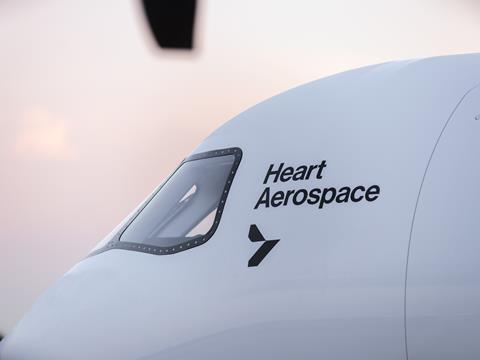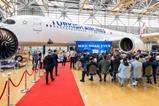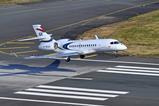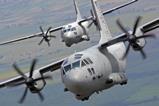If employees at Sweden’s Heart Aerospace thought the last few months were frantic as they raced to complete the HX-1, the developer’s first full-scale flight demonstrator, there appears no let-up in sight as they contemplate the multiple hurdles that must be cleared if they want to achieve a maiden sortie next year.
“Our team has been working around the clock through the summer to get the aircraft ready,” says chief executive and co-founder Anders Forslund.
But perhaps upsettingly for some employees, the next steps on the path to first flight include the partial dismantling of the aircraft they have so painstakingly assembled.

Unveiled on 12 September at the company’s Gothenburg Save airport facility, the HX-1 will perform its first flight in the USA, but where exactly will be determined by whether there is a pilot on board.
With the HX-1 due to be dismantled and transported to the USA before the end of the year, figuring out its final destination is a pressing issue, says Forlsund.
“We are shipping this out in late October, early November, so I hope by then we know where we are sending it to, otherwise we are going to take this uncertainty management a little bit to its extreme.”
Forslund sees advantages from both options, but adds: “We are doing some more tests to find out which is the fastest route [to flight].”
Prior to its disassembly, the all-composite prototype will be subjected to a ground-test campaign to validate its systems.
The exact process is still being finalised, says chief technology officer Ben Stabler, who heads the company’s research and development centre in California. “We are working on the sequencing of tests to get the maximum value out having the HX-1 here versus over there.”

First flight is planned for the second quarter of 2025, but Forslund says this could take place as early as April if everything goes to plan.
Built largely in-house, the HX-1 features a fully composite fuselage and wing and is a stepping-stone on the path towards Heart’s development of its ES-30, a hybrid-electric airliner capable of flights of 108nm (200km) on battery power alone, or up to 215nm also using its turboprop engines.
However, unlike the eventual commercial product, power for the HX-1 is provided solely by four 400kW electric motors from Italian firm Phase.
And due to the design freeze on the HX-1 taking place prior to a major change to the ES-30’s configuration in May, it will still feature the wing-strut now absent from the final version.
The HX-1 will be followed in 2026 by the next prototype, the HX-2, the first to be quipped with its “independent hybrid powertrain”: a pair of turboprop engines on the outboard part of the wing and twin inboard electric motors.
That aircraft will also be the first to use Heart’s new integrated nacelle design, which it claims will minimise the aerodynamic interference between the wing and nacelle at high angles of attack, reducing the stall speed and boosting short field performance, taking it down to 1,100m (3,600ft) or less.
For comparison, the 30-50-seat ATR 42-600S – the twin-turboprop’s short take-off and landing variant – can access runways between 800m and 1,000m long, depending on payload and mission length.

Stabler says the nacelle has industry-wide applications: “This is not specific to the Heart aircraft. In fact, this design could be leveraged on other aircraft with a similar wing configuration.” Heart has applied for a patent for the nacelle.
The HX-2 will also be equipped with electric motors that are each sized at 1.6MW, significantly more powerful than those of the HX-1. The turbine engines, meanwhile, will each be in the 1,000-1,500hp (745-1,120kW) range. Heart plans to use the same configuration and output on the ES-30.
Suppliers for both the thermal and electric engines have yet to be determined.
Development of the control system for the powertrain will occupy much of Stabler’s team over the coming months, work on which is part-funded by a $4.1 million grant from the US Federal Aviation Administration.
Heart intends to have two throttle levers controlling the two pairs of engines, with the system capable of allocating power as required, particularly during longer hybrid flights.
Although flights under 108nm will be flown almost entirely on electric power, the turboprops will be brought on line during landing in case a go-around is required.
Heart is also taking battery development back in-house. “We think it’s really important for any electric aircraft manufacturer to have a strong understanding of battery technology and how it integrates into the aircraft and the safety case as well,” says Stabler.

Dialogue will continue with external suppliers but “we are also building that competency internally”, he says.
A previous iteration of the ES-30 saw the batteries – accounting for around 20% of the maximum take-off weight – housed in a dedicated bay below the fuselage, but following the redesign earlier this year, they have been relocated to a compartment aft of the passenger cabin. Stabler also intends to look for weight savings across the aircraft in the coming months.
Heart is promoting the ES-30 as a 30-seat aircraft but is also contemplating a 34-seat option – removing the lavatory and instead installing an extra row of four seats at the rear of the cabin while largely maintaining a 30in pitch.
In parallel with the development of the ES-30 – the first versions of which should begin to appear from late 2027 – Heart is working on its production model.
Forslund says its planned “pilot factory” will feature an automated carbonfibre lay-up system that allows it to “make a whole fuselage or wing in a matter of hours” without the need for an autoclave.
Heart has already ordered several smaller machines which will be used for the production of parts for the HX-2 which “we can learn lessons on”.

High levels of automation and other next-generation manufacturing technologies should permit assembly of one aircraft per month in the pre-production phase, rising as high as one per week once in service.
“We are looking to build this factory from the ground up and we are super excited about the discussions we are having with a bunch of stakeholders about the construction and financing of this assembly facility,” he says.
No decision has been taken on the location for the pilot factory – the first in a proposed global network such sites – but by 2027 “we want to be getting in to our own facility”.
Public subsidies may ultimately determine the location, however. Describing the ES-30 as a “billion-dollar project”, Forslund points out that “no aerospace company has succeeded without significant governmental support”.
Heart will also continue to seek private capital, building on last year’s Series B funding round that brought in a little over $100 million, taking the total raised since incepetion to $145 million.
Having a vertically integrated production system will allow Heart to incorporate changes faster, avoiding the long lead times these can introduce when dealing with external suppliers, Forslund argues.
“We want to be making sure we are in control of timelines and can make these [design] shifts and rapid iterations,” he says.
Nonetheless, the exact balance of internal versus external suppliers for full-rate production has yet to be settled on.
However, the combination of the design and production changes has also pushed back the ES-30’s service entry to 2029, a delay of around one year from its previous target. It also saw a total of 72 redundancies at the Swedish operation, according to its annual report.
While that slight delay may not matter in the long term, until pre-delivery payments kick in there is no revenue coming through the door and plenty of cash being spent on development. Last year losses more than doubled to SKr531 million ($51 million), up from SKr243 million in 2022, according to the company’s latest annual report.

Firm orders stand at 250, the overwhelming majority from Mesa Airlines and United Airlines, who have each signed for 100 aircraft. In addition, Heart holds 120 options and purchase rights, plus 191 letters of intent (LoI), the most recent of which came in December from US carrier JSX for up to 100 aircraft.
Crucially, Heart has continued to grow its advisory board, in early September signing up AirAsia and Loganair, adding to existing partners including Air New Zealand, Braathens Regional Airlines, an IAG carrier – understood to be BA CityFlyer – KLM and SAS, among others.
“In terms of the advisory board, which is a good signal of commercial traction, I am very happy with the progress to date,” says chief commercial officer Simon Newitt.
Working with an airline like AirAsia “that is absolutely obsessed with driving costs down” is important, he says, as its scrutiny will “keep us laser-focused on meeting our value proposition” of delivering “accessibility, sustainability and affordability”.
“Having patient advisory board partners that really understand the challenges and are engaged enough to allow us to go away and ensure we are getting the configuration right is very important. We all know the orders are conditional, reflecting the level of maturity of the product, but we feel we are building trust and a level of credibility with the market.
“There will be an appropriate time when we start to see the conversion of some of those LoIs to orders, and perhaps some of those advisory board members who have not taken a position moving down the sales funnel.”
Heart has always been clear that the ES-30 is just the start of a family of aircraft, potentially stretching to a 100-seater or above to play a “major role in decarbonising the larger narrowbody market”, says Forslund.
No decision has been taken to launch such an aircraft, he stresses, but as part of his presentation, Forslund displayed an image of a larger design featuring rear-mounted engines.
Improvements in battery performance could also eventually allow Heart to “eliminate the turboprops altogether and fly all-electric” on the 30-seater.





















































